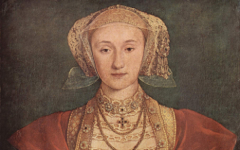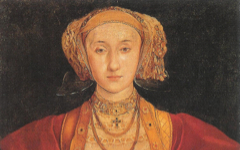Holbein’s Portrait of Henry VIII (c.1537)
There is a strong and seemingly growing belief among those who study portraiture that patrons, especially in the pre-modern era, stipulated how they should appear and that the composition was as much influenced by the sitter as by the artist. They describe it as "a negotiation" between the two 1. This may be true of minor portraitists whose principal objective was shared by the patron, the capture of a true likeness for posterity. Yet the evidence is fairly clear by now that true artists, visual poets not graphic hacks, had different objectives guided by different rules. We need to look at their portraits with a different eye. Sitters who commissioned artists like Botticelli, Giovanni Bellini, Titian and later Rembrandt frequently observed, and often complained, that their portrait looked little like them.2 Even in the 16th century thoughtful art lovers were asking why the best artists seemed to produce the worst likenesses, a puzzle that continued to concern thinkers in the eighteenth century.3 It puzzled them though their concerns and the sitters' complaints which are well documented generally remain uncited by those more interested in the personality and biography of the sitter than the poetry of the artist.

Hans Holbein the Younger, Portrait of Henry VIII (c.1537) Oil on panel. Museo Thyssen-Bornemisza, Madrid
Click image to enlarge.
No draughtsman has ever produced a more convincing portrayal of a living presence in portraiture than Hans Holbein. Even photographs when compared to his portraits can look lifeless. His celebrated images of King Henry VIII, though, required a level of remove, an heiratic presence, not necessary in his other portraits. Yet despite fear, perhaps, of execution himself if the king knew what he was really up to, Holbein executed the king's portrait as artists execute almost all their sitters, as a symbolic portrait of himself.
Click next thumbnail to continue

L: Detail of Holbein's Portrait of Henry VIII (c.1537)
R: Detail of Holbein's Self-portrait (c.1542)
Click image to enlarge.
If we compare the king's face (l) to Holbein's (r) there are hidden resemblances. The lines of their eyebrows are very similar as is the opening of the nostril. Holbein who seems to have had a rectangular-shaped beard maintained a similar right-angle in the king's. Of course, Henry may have worn such a beard but Holbein regularly squared his sitter's features to echo that characteristic of his own face. Most subtly, the royal lips while narrower echo the central portion of Holbein's.4
Click next thumbnail to continue
The alphabet was in Holbein's favor too. He shared the same initials with the king. Hanging around Henry's neck is a gold chain formed from a string of H's, both for Henry and, repetitively, for Hans Holbein. Gold chains have great significance in art granted by royal patrons in the 16th and 17th centuries to their favored artists who proudly display them in their self-portraits. [See the theme State Honors.] They can be seen on Titian, Rubens and Van Dyck, even Rembrandt who never actually received one.
Click next thumbnail to continue
There is a possibility, too, that Henry's headgear was chosen by the artist or its key features accentuated for his own purposes. It is flat and curved so that its basic form could have suggested to Holbein the shape of a palette. This is strengthened by the focus on the plume's long, thin contour because textures like feathers and fur were often used as symbols for a paintbrush which is long and thin too. [See, for example, Ferdinand Bol’s Portrait of a Man Holding a White Plume (1648).] If so, and I am not certain, Henry is Holbein-as-king with a palette and paintbrush on his mind, not unlike some of the hats I have already revealed on Rembrandt's beggars.5
Click next thumbnail to continue
Henry's rings also give the impression of eyes (top). This is likely because, worn on fingers, they effortlessly combine eye/vision with hand/craft. Titian did the same in a portrait of a pope.6 These "eyes" are also positioned near the lower edge as though Henry above them is present in Holbein's mind. Furthermore, the ring on the right is rectangular while the other is a horizontal oval, not unlike the difference in shape in Holbein's own eye-openings (bottom). Besides, the shading under the right-hand ring, which is lit though surrounded by darkness, is curved like the lower edge of an eye. Many artists have placed such "eyes" at the lower edge of a frame for the same purpose as I have already shown in Dürer's 1500 Self-portrait.
See conclusion below
The last two ideas are not certain, just food for thought. They are important to note because the future discovery (by you, me or someone else) of something similar in other works by Holbein may later confirm them. Perhaps, then, this is an opportunity to remind some of you that it is good to think courageously. Learn as much as you can about art by looking and reading but when you think throw caution to the winds. Art, few people realize, demands it.
More Works by Holbein
Sent on a mission to paint a potential queen for the blood-thirsty and dangerous Henry VIII, how did Holbein "paint" himself in painting the future Queen?

Holbein’s Anne of Cleves (c.1539)
Notes:
1. Peter Burke, The Historical Anthropology of Early Modern Italy: Essays on perception and communication (Cambridge University Press) 1987, p. 153; Zbynek Smetana, Titian’s Mirror: Self-Portrait and Self-Image in the Late Works, PhD. Diss. (Rutgers University, NJ) 1997, p. 6
2. Isabella d’Este who rejected one of Mantegna's portraits thought he was no good at painting them. She wrote: “the painter has done his work so badly that it does not resemble us in the slightest way” and complained in a separate letter that it was difficult to find a good painter who could "counterfeit perfectly the natural face." Ludovico Gonzaga noted of Mantegna: “Andrea is a good master in other things, in portraits he could have more grace – in portraits he does not do so well.” Woods-Marsden recounts how “when..Pisanello and Jacopo Bellini made competitive portraits of Leonello dEste in 1441, the Marchese found it incomprehensible that he could not persuade the two artists to reconcile their different rendering of his features.” Both Domenico Ghirlandaio and Rembrandt had sitters who were so upset with their likeness that the former was taken to arbitration, the latter to court. For D'Este's and Gonzaga's complaints, Joanna Woods-Marsden, “Ritratto al Naturale”: Questions of Realism and Idealism in Early Renaissance Portraits”, Art Journal 46, Fall 1987, pp. 210-11; D'Este's comment on the "natural face" and Ghirlandaio, Patricia Rubin, “Understanding Renaissance Portraiture” in The Renaissance Portrait: From Donatello to Bellini (New York: Metropolitan Museum of Art) 2011, p. 5.
3. Mary D. Sheriff, “Invention, Resemblance and Fragonard’s Portraits de Fantaisie”, Art Bulletin 69, Mar. 1987, p. 79
4. Although the self-portrait used here post-dates the king's portrait, Holbein almost certainly drew other self-portraits, now lost, in an identical pose. It is one of the characteristics of a poetic draughtsman's self-portraits that they maintain the exact turn of the head in one example after the other over many years though artists producing many self-portraits like Rembrandt and Van Gogh tended to vary the pose occasionally but not often.
5. See Rembrandt's Beggar in a High Cap (c. 1629)
6. Titian's Portrait of Pope Paul III and His Grandsons (1545-6)
Original Publication Date on EPPH: 03 Aug 2013. © Simon Abrahams. Articles on this site are the copyright of Simon Abrahams. To use copyrighted material in print or other media for purposes beyond 'fair use', you must obtain permission from the copyright owner. Websites may link to this page without permission (please do) but may not reproduce the material on their own site without crediting Simon Abrahams and EPPH.





